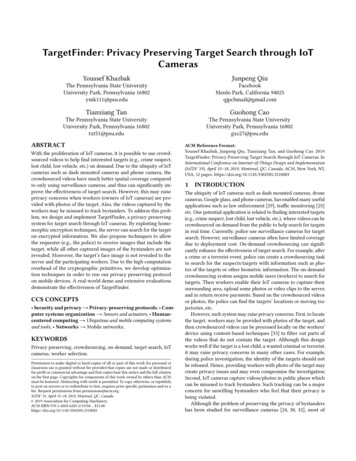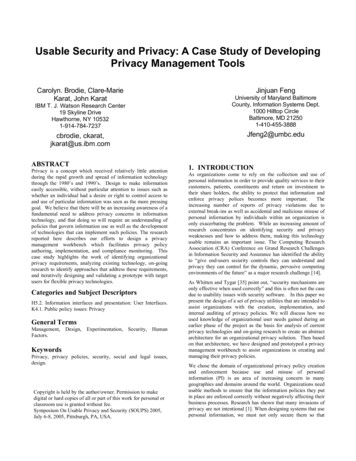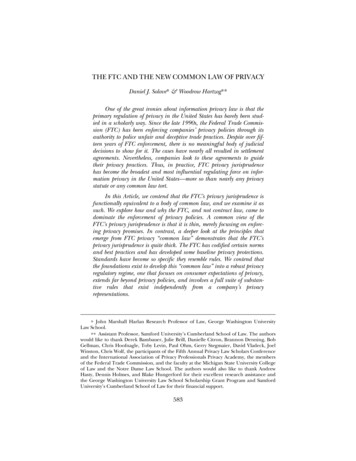
Transcription
TargetFinder: Privacy Preserving Target Search through IoTCamerasYoussef KhazbakJunpeng QiuThe Pennsylvania State UniversityUniversity Park, Pennsylvania 16802ymk111@psu.eduFacebookMenlo Park, California 94025qjpchmail@gmail.comTianxiang TanGuohong CaoThe Pennsylvania State UniversityUniversity Park, Pennsylvania 16802txt51@psu.eduThe Pennsylvania State UniversityUniversity Park, Pennsylvania 16802gxc27@psu.eduABSTRACTWith the proliferation of IoT cameras, it is possible to use crowdsourced videos to help find interested targets (e.g., crime suspect,lost child, lost vehicle, etc.) on demand. Due to the ubiquity of IoTcameras such as dash mounted cameras and phone camera, thecrowdsourced videos have much better spatial coverage comparedto only using surveillance cameras, and thus can significantly improve the effectiveness of target search. However, this may raiseprivacy concerns when workers (owners of IoT cameras) are provided with photos of the target. Also, the videos captured by theworkers may be misused to track bystanders. To address this problem, we design and implement TargetFinder, a privacy preservingsystem for target search through IoT cameras. By exploiting homomorphic encryption techniques, the server can search for the targeton encrypted information. We also propose techniques to allowthe requester (e.g., the police) to receive images that include thetarget, while all other captured images of the bystanders are notrevealed. Moreover, the target’s face image is not revealed to theserver and the participating workers. Due to the high computationoverhead of the cryptographic primitives, we develop optimization techniques in order to run our privacy preserving protocolon mobile devices. A real-world demo and extensive evaluationsdemonstrate the effectiveness of TargetFinder.CCS CONCEPTS Security and privacy Privacy-preserving protocols; Computer systems organization Sensors and actuators; Humancentered computing Ubiquitous and mobile computing systemsand tools; Networks Mobile networks;KEYWORDSPrivacy preserving, crowdsourcing, on-demand, target search, IoTcameras, worker selection.Permission to make digital or hard copies of all or part of this work for personal orclassroom use is granted without fee provided that copies are not made or distributedfor profit or commercial advantage and that copies bear this notice and the full citationon the first page. Copyrights for components of this work owned by others than ACMmust be honored. Abstracting with credit is permitted. To copy otherwise, or republish,to post on servers or to redistribute to lists, requires prior specific permission and/or afee. Request permissions from permissions@acm.org.IoTDI ’19, April 15–18, 2019, Montreal, QC, Canada 2019 Association for Computing Machinery.ACM ISBN 978-1-4503-6283-2/19/04. . . 15.00https://doi.org/10.1145/3302505.3310083ACM Reference Format:Youssef Khazbak, Junpeng Qiu, Tianxiang Tan, and Guohong Cao. 2019.TargetFinder: Privacy Preserving Target Search through IoT Cameras. InInternational Conference on Internet-of-Things Design and Implementation(IoTDI ’19), April 15–18, 2019, Montreal, QC, Canada. ACM, New York, NY,USA, 12 pages. ONThe ubiquity of IoT cameras such as dash mounted cameras, dronecameras, Google glass, and phone cameras, has enabled many usefulapplications such as law enforcement [29], traffic monitoring [25]etc. One potential application is related to finding interested targets(e.g., crime suspect, lost child, lost vehicle, etc.), where videos can becrowdsourced on demand from the public to help search for targetsin real time. Currently, police use surveillance cameras for targetsearch. However, surveillance cameras often have limited coveragedue to deployment cost. On-demand crowdsourcing can significantly enhance the effectiveness of target search. For example, aftera crime or a terrorist event, police can create a crowdsourcing taskto search for the suspects/targets with information such as photos of the targets or other biometric information. The on-demandcrowdsourcing system assigns mobile users (workers) to search fortargets. Then workers enable their IoT cameras to capture theirsurrounding area, upload some photos or video clips to the server,and in return receive payments. Based on the crowdsourced videosor photos, the police can find the targets’ locations or moving trajectories, etc.However, such system may raise privacy concerns. First, to locatethe target, workers may be provided with photos of the target, andthen crowdsourced videos can be processed locally on the workers’device using content-based techniques [33] to filter out parts ofthe videos that do not contain the target. Although this designworks well if the target is a lost child, a wanted criminal or terrorist,it may raise privacy concerns in many other cases. For example,during police investigation, the identity of the targets should notbe released. Hence, providing workers with photo of the target maycreate privacy issues and may even compromise the investigation.Second, IoT cameras capture videos/photos in public places whichcan be misused to track bystanders. Such tracking can be a majorconcern for unwilling bystanders who feel that their privacy isbeing violated.Although the problem of preserving the privacy of bystandershas been studied for surveillance cameras [24, 30, 32], most of
IoTDI ’19, April 15–18, 2019, Montreal, QC, Canadathem have been proposed for fixed infrastructure where the privacy preserving algorithm is run on powerful servers to detectbystanders and hide their faces. Some other researchers [8, 39]consider content-based modification of captured images or videoframes, guided by a privacy policy to preserve individual privacypreferences. However, they assume that each capturing device isassociated with a trusted cloudlet located close to that device torun computation intensive tasks, which may not always be possibleespecially for users with strong privacy requirements. Moreover,none of them considers the problem of target search, and do nothave the requirement of preserving the privacy of targets as wellas the privacy of bystanders. Preserving the privacy of the target isalso hard, since the requester (e.g., the police) may not even wantto release the photo of the target to the server, which is honest butcurious and has the incentive to reveal the target or bystandersinformation in order to infer sensitive information about them. As aresult, offloading the processing of captured images or video frames,which may contain sensitive information, to the server may notwork well. Then, how to process these images or video frames onresource limited mobile devices in a privacy preserving mannerbecomes a challenge.In this paper, we design and implement TargetFinder, a privacypreserving system for target search through IoT cameras. In TargetFinder, we propose efficient image processing techniques thatcan run on mobile devices, which allow the task requester (e.g., police) and the workers to process images and videos locally on theirmobile devices to extract target’s face information and bystanders’face information. To preserve the privacy of the target and thebystanders, we propose to encrypt the target’s face informationand the bystander’s face information before sending them to theserver. By exploiting homomorphic encryption techniques [10], theserver can search for the target on encrypted information. Aftermatching the target face to the detected faces, oblivious transfer[12] is applied to allow a requester to receive images that includethe target, while all other captured images of the bystanders are notrevealed. Moreover, the target’s face image is not revealed to theserver and the participating workers. Due to the high computationoverhead of the cryptographic primitives, we develop optimization techniques in order to run our privacy preserving protocol onmobile devices.In summary, the contributions of this paper are as follows. We design and build an on-demand target search systemcalled TargetFinder, which uses videos crowdsourced fromIoT cameras to help search for the target. We propose a privacy preserving protocol for target search,which preserves the privacy of the target and the bystanders.To speed up the protocol running time, several optimizationtechniques are designed and evaluated. We have implemented a prototype of TargetFinder, anddemonstrate its effectiveness based on real experiments.The rest of the paper is organized as follows. In Section 2, wepresent the system overview. The system design and implementation are described in Section 3. In Section 4, we evaluate thesystem performance. Section 5 describes related work and Section6 concludes the paper.Youssef Khazbak, Junpeng Qiu, Tianxiang Tan, and Guohong CaoFigure 1: The TargetFinder system.2SYSTEM OVERVIEWIn this section, we first present the system overview and thenintroduce the threat model. Finally, we describe the basic idea ofour privacy preserving protocol.2.1TargetFinder OverviewTargetFinder helps locate targets using corwdsourced videos fromIoT cameras such as vehicle mounted cameras, Google glass, orphone cameras. The videos can be processed at the IoT camera orat the worker’s mobile device such as smartphones. As shown inFigure 1, TargetFinder consists of a server and a mobile app that runson the requesters’ and workers’ mobile devices. A requester can besomeone who wants to pay for getting information about the target.The requester creates a task about the target which includes someinformation such as the task description, geographical informationsuch as possible locations of the target, and the photo of the target.If privacy is not a concern, the photo of the target will be shown tothe workers. In this paper, we focus on tasks with privacy concerns,and thus the photo will not be shown to the workers. The photo ofthe target will be used by the privacy preserving algorithm so thatonly matched video frames are sent to the requester to protect theprivacy of the target and the bystanders.With the photo of the target, Face Detection, Face Preprocessing,and Feature Extraction are executed to detect the target’s face andextract its feature vector. On the worker side, after videos are captured, they are processed to select some video frames, referred toas captured photos. Based on these captured photos, Face Preprocessing, and Feature Extraction are executed to process faces, andextract their feature vectors. Then the proposed Privacy Preservingprotocol is used for target search which preserves the privacy ofthe target and the bystanders.
TargetFinder: Privacy Preserving Target Search through IoT CamerasOn the server side, each task has a Task Manager which stores thetask information, tracks the progress of the task, selects participantworkers, and sends notifications to the selected workers. TheTaskManager notifies workers by pushing the task notification to theirmobile devices. This is implemented by using the Firebase CloudMessaging (FCM) service [6] provided by Google.2.2Threat ModelTargetFinder preserves the privacy of the target and bystanders byconsidering the following threat model. The server is honest butcurious who has the incentive to reveal the target or bystandersinformation in order to infer sensitive information about them.The requesters and workers are assumed to follow the privacypreserving protocol, but may try to learn extra information fromthe received information. We assume that the requesters and theserver do not collude.TargetFinder addresses the privacy concerns of the target andthe bystanders by employing cryptographic primitives to privatelymatch the target face to the captured faces. The requester only receives the matched photos that include the target, not other photos.Moreover, the target information is not revealed to the server andthe participating workers such that only the requester knows theidentity of the target, and can discover his location.2.3Basic Idea of the Privacy PreservingSolutionTo search for the target in the captured images while preservingthe privacy of both the target and the bystanders, we propose thefollowing privacy preserving protocol. First, the requester generates a public and private key pair, and creates a task to search forthe target with the photo of the target. The feature vector of thetarget is extracted, and encrypted using the requester’s public key.Then, he sends the public key and the encrypted feature vector tothe server. The server selects and notifies participating workers,and then broadcasts the public key to all selected workers. On theworker side, images are processed, and feature vectors are extracted.The extracted feature vectors are encrypted using the public key,and sent back to the server. For each detected face, the server computes the encrypted dot product of the following two vectors: theencrypted feature vector of the detected face and that of the target.The encrypted dot products are returned to the requester. Then, therequester decrypts and selects photos that include the target basedon a predetermined threshold. Finally, the requester can initiate theoblivious transfer protocol to retrieve the selected photos from theserver.To compute the dot product on encrypted feature vectors, it isrequired to do additions and multiplications over ciphertexts. Whilepartially homomorphic encryption is in general more efficient thanSomewhat-Homomorphic encryption (SHE) [10], it only allowsadditions or multiplications on encrypted data, but not both at thesame time which is required for computing the dot product. Thus,we use SHE based on ideal lattices [10] which allow the server tocompute the dot product on ciphertexts produced by the requesterand the workers. However, it has high computation overhead as itdoes additions and multiplications over ciphertext represented byring of polynomials, which will be addressed in this paper.IoTDI ’19, April 15–18, 2019, Montreal, QC, Canada3TARGETFINDER DESIGN ANDIMPLEMENTATIONIn this section, we describe the design and implementation of TargetFinder’s two major components: image processing and privacypreserving target search. Image processing will be used in our privacy preserving protocol, and hence we first describe it.3.1Image ProcessingIn TargetFinder, face detection is executed first to detect faces inevery video frame. Then, frames with the most number of detectedfaces are selected, and finally features are extracted from theseframes. The following describes the details of these techniques:face detection, frame selection, face preprocessing, and featureextraction.Face Detection: The first step is to detect faces in images orvideo frames. There are several face detection libraries available onAndroid. For example, the Android SDK includes a face detectionAPI. However, it is not accurate and may miss the detection of manyfaces. In TargetFinder, we use the face detection algorithm calledHaar feature-based cascade classifier from the OpenCV library [7].It has much higher accuracy compared to the Android face detectionAPI, and allows flexible configurations with various parameters,such as image scaling, minimum size of a face, etc.Frame Selection: Extracting feature vectors of all detected facesfrom all video frames takes a long time and enormous computational power. Moreover, there are usually minor changes betweenconsecutive video frames and the target will appear in many consecutive frames, and hence sampling video frames at a lower rateworks well on capturing the targets. Therefore, to remove the redundancy, we select only one frame every second, and the framewith the most number of detected face is selected. Based on thecomputation capability of the IoT camera, more frames may beselected. It is possible that frames can be better selected based onother factors such as the face image quality. Since the focus of thispaper is the privacy preserving protocol, we will leave it as futurework.Face preprocessing: For the selected frames, the faces are preprocessed before extracting feature vectors. Preprocessing is neededbecause the detected faces may have various sizes, positions, andorientations which affect the results of the feature extraction algorithm. In preprocessing, image grayscale conversion, resizing, andface alignment are performed. The face alignment aligns the landmarks of the face (e.g. eyes, nose and mouth) to appear at roughlythe same position in the final output images. In TargetFinder, we useDlib [5] to detect the face landmarks, and transform the landmarksto the positions specified by the feature extraction algorithm.Feature Extraction: There are several feature extraction algorithms, such as Eigenfaces [38], and Light convolution neuralnetwork (CNN) [40]. Eigenfaces represents a human face with aset of eigen vectors, while Light CNN represents a human faceusing a 256 dimensional feature vector extracted from a 29-layerCNN. Light CNN has several advantages over other algorithms.First, it can achieve a much higher face verification accuracy (i.e.,99%). Moreover, the size of the Light CNN model is only 33MB,much smaller than many other CNN models such as the VGG Network [34] which is about 580MB. This makes it more suitable to be
IoTDI ’19, April 15–18, 2019, Montreal, QC, CanadaYoussef Khazbak, Junpeng Qiu, Tianxiang Tan, and Guohong Caorun on smartphones. Thus, we use Light CNN for feature extraction,and the Android ported Caffe deep learning framework [3, 16] isused in our implementation to run Light CNN.After extracting the feature vector of the target face and thoseof the captured faces, the feature vector of target face is comparedwith that of each detected face. The comparison is by computingthe dot product of the two vectors. If the dot product is above apredetermined threshold, the detected face matches the target face.In our system, such comparison is done privately as described inSection 3.2 to preserve the privacy of the targets and the detectedfaces.Performance Optimization: The extracted feature vectors areused in the privacy preserving protocol. Such protocol is based oncryptographic primitives which are computationally intensive, andthe running time depends on the dimension of the feature vectors.To reduce the running time, we reduce the dimension of the 256dimensional feature vectors using principal component analysiswhich linearly projects high dimensional data into a lower dimensional space. The projection is done by multiplying original featurevectors by a transformation matrix to transform the feature vectorsinto b-dimensional space. To obtain the transformation matrix, wefirst extract facial feature vectors, and then perform singular valuedecomposition on the extracted vectors. The transformation matrixis represented by the b most significant components. With suchdimensionality reduction, we can speed up the execution of thecryptographic protocol with the cost of face recognition accuracy.We study such tradeoff in the performance evaluations (Section 4)to choose a reasonable b-dimensional space.To improve the performance of image processing, we use multithread to process multiple frames simultaneously. As the JNI codeof the Caffe framework is not thread-safe, we modify the code toallow each thread to hold its own instance of the neural networksfor feature extraction. As the feature extraction is the most computational intensive task, we use one thread to run face detection,one thread for frame selection, and multiple threads to preprocessfaces and run multiple instances of Light CNN to extract featurevectors in parallel.by sampling s χ ; i.e., sk s. To generate the public key, wefirst sample uniformly at random a 1 Rp , and sample smallerror e χ . Then the public key is pk [a 0 (a 1s te), a 1 ].Given this public key and a message m, the encryption is performedby sampling u, д, h χ and outputs the following ciphertext:c [c 0 , c 1 ] [a 0u tд m, a 1u th].SHE allows additions and multiplications on ciphertexts. Giventwo ciphertexts c [c 0 , c 1 ] and c ′ [c 0′ , c 1′ ], we can add them toobtain a ciphertext cadd [c 0 c 0′ , c 1 c 1′ ]. Similarly, the productof the two ciphertexts is cmlt [c 0c 0′ , c 0c 1′ c 0′ c 1 , c 1c 1′ ]. The homomorphic multiplication increases the number of ring elements inthe ciphertext. Hence, the encrypted vector dot product returnedto requester includes one extra polynomial, i.e., cmlt [c 0 , c 1 , c 2 ],and the decryption can be computed using the private key sk asfollows: m (c 0 c 1s c 2s 2 ) mod t.k-out-of-n Oblivious Transfer: The k-out-of-n oblivious transfer protocol, denoted OTkn , is a two party protocol that allows arequester to privately choose k out of n images from the server. Therequester learns k images and nothing else, and the server learnsnothing about the chosen k images. In our implementation, we usethe OTkn scheme [12] which is as follows. A requester constructsa k-degree polynomial function with roots equal to the selectedindices, and then hides this polynomial in another random k-degreepolynomial function. The masked polynomial coefficients are sentto the server. Because of the random polynomial function, the servercannot learn about the selected indices from the masked polynomialcoefficients, and it can only use such coefficients to encrypt theimages and send them back to the requester. Finally, the requestercan only decrypt images of the selected indices. All other n kimages are unknown to the requester and cannot be decrypted.3.2Privacy Preserving Target SearchIn this section, we first describe the cryptographic primitives andthen introduce our privacy preserving protocol for target search.3.2.1 Cryptographic PrimitivesSomewhat-Homomorphic encryption (SHE): SHE allows additions and multiplications over ciphertexts, while partially homomorphic encryption allows only addition or multiplication overciphertexts. Thus, by using SHE, the server can compute the vectordot product on ciphertexts produced by the requester and the workers. In TargetFinder, we use the SHE scheme based on ideal latticesdescribed in [10]. In the following, we describe its basic idea.The plaintext m resides in the ring of polynomials with coefficients in Zt , i.e., m R t Zt [x]/(x d 1), and the ciphertextspace is in Rp Zp [x]/(x d 1). The parameters p and t are positive integers, where p t 1, and they define the upperboundof the ciphertext and plaintext coefficients respectively. Let χ bethe error distribution in Rp , then the private key (sk) is obtainedTable 1: Table of notationsParameterpkskdzftF wiqnkDescriptionSHE public keySHE private keyDegree of the polynomialNumber of selected workersFeature vector of the targetExtracted feature vectors of worker w iDimension of the feature vectorNumber of images captured by selected workersNumber of images selected by the requester3.2.2 Privacy Preserving Target SearchOur privacy preserving protocol works as follows. First, the requester generates a public and private key pair, and creates a taskto search for the target with the photo of the target. The featurevector of the target is extracted, and encrypted using the requester’spublic key. Then, he sends the public key and the encrypted featurevector to the server. The server selects and notifies participatingworkers, and then broadcasts the public key to all selected workers. On the worker side, after selecting video frames, the capturedphotos (frames) are processed and feature vectors are extracted.The extracted feature vectors are encrypted using the public key,
TargetFinder: Privacy Preserving Target Search through IoT CamerasRequesterIoTDI ’19, April 15–18, 2019, Montreal, QC, CanadaServerWorkerFigure 2: Our privacy preserving protocoland sent back to the server. For each detected face, the server computes the encrypted dot product of the following two vectors: theencrypted feature vector of the detected face and that of the target.The encrypted dot products are returned to the requester. Then,the requester decrypts and selects photos that include the targetbased on a predetermined threshold. In case the target is found insome photos, the requester initiates the oblivious transfer protocolto retrieve these photos from the server. The used parameters aresummarized in Table 1.Baseline protocol: A straightforward implementation of thisprotocol incurs high computational overhead and high bandwidthconsumption for several reasons. First, a worker may capture multiple faces, and hence needs to encrypt several feature vectors. Toencrypt m feature vectors with q dimensions, mq encryptions areneeded to generate mq encrypted polynomials. Second, the serverneeds to compute encrypted dot products of the feature vectors. Forz selected workers, each with m feature vectors, zm dot product calculations are required, and zm encrypted dot products, representedby a polynomial of d coefficients, are returned to the requester.Then, the requester needs to decrypt zm encrypted dot products.This results in high computational overhead at the server and therequester, and high bandwidth consumption between the requesterand the server.Optimized protocol: To reduce the high computational overhead of the baseline protocol, we propose the following optimizations. First, for a worker w i , the number of encryptions can bereduced from mq to q as follows. Let matrix F w i store the m featurevectors, each with q dimensions. To encrypt the feature vectors, wefirst generate a polynomial from each row of the matrix, to have qpolynomials, each storing m feature values. Then, the requester’spublic key is used to encrypt the q polynomials. Thus, we only haveq encryptions.Second, at the server, we pack the ciphertext to compute the dotproduct in parallel for all zm feature vectors, hence reducing thecomputational overhead. After computing the dot products, only asingle encrypted polynomial is returned to the requester and hencereducing the bandwidth consumption. The requester decrypts it toget a polynomial of degree d, where each coefficient represents adot product value. More specifically, the ciphertext is packed intoq polynomials. For a polynomial, each coefficient represents an
IoTDI ’19, April 15–18, 2019, Montreal, QC, CanadaYoussef Khazbak, Junpeng Qiu, Tianxiang Tan, and Guohong Caoelement of different feature vector. Thus, to independently computethe dot product of each feature vector with that of the target, weneed coefficient wise homomorphic operations. Polynomial additions are naturally coefficient wise, but polynomial multiplicationsresult in convolution product of the coefficients. To transform convolution products into coefficient wise products on rings, we usethe Number Theoretic Transform (NTT) which is a discrete Fouriertransform specifically for finite rings. To transform convolutionproducts on the encrypted polynomials into coefficient wise products on the plaintext polynomials, we apply an inverse-NTT toplaintexts before encryption, and then an NTT to the plaintextafter decryption. These transformations do not affect polynomialadditions as they are linear transformations.Third, encrypting/decrypting captured images with SHE involves computations of many polynomials, and hence inefficient.To address this problem, we use a hybrid approach, where imagesare encrypted and decrypted using AES symmetric-key, and onlythe short AES key is encrypted and decrypted using SHE.Figure 2 shows the protocol, which is described as follows.(6) The requester constructs a polynomial function of degree k:Í 1f ′ (x) ki 0bi x i x k , where f ′ (i) 0, iff i {σ0 , ., σk 1 }.Í 1Then she generates a random polynomial f (x) ki 0ai x i x kwhich is used to compute l [l 0 , ., lk 1 ], where li дai hbi .Then she sends l to the server.k 1k(7) For each image i, the serve computes r i l 0l 1i .lki 1 (дh)i ,generates a secret key ki , and encrypts the image using a hybridapproach. The hybrid approach first encrypts the image usingAES encryption key si , i.e., ui AES.Enc(si , vi ), and encryptssi using the public key, i.e., c i (дki , si r iki ). The server sendsthe following to the requester: the encrypted images u, theencrypted symmetric keys c and the encrypted symmetric keyscks .Finally, for every index in {σ0 , ., σk 1 }, the requester can getkσthe symmetric key s σi by computing s σi s σi r σi i /дk σi f (σi ) . Theselected images u σi can be decrypted with the symmetric keys s σi ,c kw i , and the SHE private key sk.s3.2.3 Privacy Analysis(1) The requester generates a SHE public and private key pair, denoted as pk and sk. Then, she extracts the feature vector of thetarget with q dimensions, denoted by f t . Each element of the feature vector is represented by a polynomial of degree d as follows.Í 1 t jFor each fit , we have pit dj 0fi X . Inverse-NTT (NTT 1 )is applied to the polynomials and result is encrypted with pk,t ]. Then,i.e., c it SHE.Enc(pk,NTT 1(pit )), and ct [c 0t , ., cq 1pk, and ct are sent to the server.(2) After notifying the participant workers, the server broadcaststhe public key pk and a random index w i to each participatingworker.(3) Worker w i extracts the matrix F w i which represents the feature vectors of detected faces in the captured photos. Eachrow of the matrix F w i is represented by a polynomial, i.e.,Íw i w i jpiw i m. Similar to the requester, the inversej 0 Fi j XNTT is applied to the polynomials and the result is encryptedwith pk; i.e., c iw i SHE.Enc (pk,NTT 1(piw i )). In addition, sheencrypts each captured image I j w i using AES symmetric keywiiks as follows: v wj AES.Enc(ks , I j ), and encrypts ks usingpk, i.e. c kw i SHE.Enc(pk, ks ). Then she sends to the server thesfollowing: cwi , vwi , c kw i , and a matrix that maps each image tosits extracted feature vectors denoted by M.
The Pennsylvania State University University Park, Pennsylvania 16802 ymk111@psu.edu Junpeng Qiu Facebook Menlo Park, California 94025 qjpchmail@gmail.com Tianxiang Tan The Pennsylvania State University University Park, Pennsylvania 16802 txt51@psu.edu Guohong Cao The Pennsylvania State University University Park, Pennsylvania 16802 gxc27@psu .










